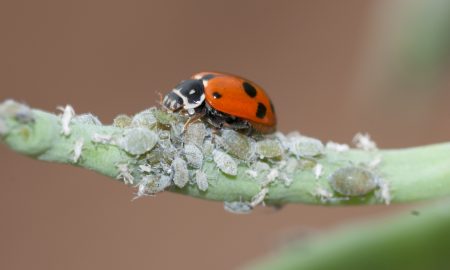Very few species of springtails are regarded as crop pests around the world.
There have been numerous enquiries regarding springtails from growers and advisors this season.
The same autumn-winter conditions that have favoured the build-up of lucerne flea, has also resulted in large numbers of other springtails.
What are springtails?
Springtails (Collembola) are one of the most abundant of all macroscopic invertebrates.
They are frequently found in leaf litter and other decaying material, as well as gathering in rafts on the surface of puddles.
Springtails are wingless, soft-bodied and have antennae.
Their body shape can range from globular to elongated.
The common name springtail is attributed to the forked-appendage underneath their abdomen, which enables them to jump off vegetation when disturbed.
Mostly detritivores
The most infamous springtail in broadacre crops and pastures is the lucerne flea (Sminthurus viridis), known for creating holes and windows in leaf foliage.
Despite the notoriety of lucerne flea as an agricultural pest, most springtail species are primarily detritivores (they feed on dead organic matter) and are generally no cause for concern.
In previous years, we have identified the springtail, Entmobrya unostrigata, feeding on legume and oilseed seedlings. This species belongs to the Family Entomobryidae and is known to be an occasional pest of field crops and pastures. It is a slender insect, approximately 2-3 mm long when adults. We have not yet seen this species in samples sent to us this season.
Those species (except lucerne flea) that occasionally feed on crop seedlings are very unlikely to cause economic injury and should not be a concern to growers.
Diversity, diversity, diversity
There are thousands of springtail species, which come in all sorts of shapes, sizes and colours.
The most commonly observed in crops and pastures in south-eastern Australia is the ‘purple scum’ springtail, from the family Hypogastruridae. These elongate purple springtails are reported every year.
This season globular purple-blue springtails have also been reported to us from Victoria’s Northern Country in a rye and shaftal clover pasture.
Very abundant critters
Under the right conditions, the population size of springtails is quite staggering. It is not uncommon to find populations exceeding 100,000 per m2 in some paddocks.
While these numbers can at first seem ‘alarming’, the vast majority of species do not feed on plant material.
Acknowledgements
Field reports
Alistair Crawford – ADAMA Australia (Wimmera, VIC)
Ellen Grinter – Advanced Ag (Northern Country, VIC)
Tony Kelly – Advanced Ag (Northern Country, VIC)
Matthew Sparke – Sparke Agricultural & Associates (Mallee, VIC)
Cover image: Photo by Andrew Weeks, Cesar Australia





